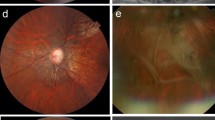Abstract
Following pupillary dilatation and immobilization of the dog with a cataleptic drug (I-Polamivet, Hoechst) the electroretinogram (ERG) was performed with the technique of Ganzfeld stimulation. The head of the dog was kept within a sphere of 60 cm diameter, the white inner surface of which could be indirectly illuminated with a stroboscope producing light flashes of 10 μsec duration. The ERG was recorded oscillographically by means of modified contact lenses. Dogs were tested for rod and cone function with luminance curves including white, blue and red stimuli and with trains of repetitive photic stimuli. Tests were performed under dark and light adaptation. The ERG of the dark-adapted dog, an indicator for the electrical activity of the rod system, was similar with that of man with respect to configuration and other characteristics. The electrical activity of the cone system was different from that of man by having a 10-fold lower sensitivity and a reduced capability for discrimination of red versus blue or white stimuli.
Similar content being viewed by others
References
L.F. Rubin,Atlas of Veterinary Ophthalmoscopy (Lea and Febiger, Philadelphia, 1974.
A. Cerletti andW. Meier-Ruge,Toxicological Studies on Phenothiazine-Induced Retinopathy, Proc. Eur. Soc. Study Drug Toxicity9 (1968);Toxicity and Side-Effects of Psychotropic Drugs, (Excerpta Medica Foundation Amsterdam, 1968).
P. Gouras,Electroretinography: Some Basic Principles, Investve Ophth.9, 557–569 (1970).
R.W. Rodieck,Components of the Electroretinogram — a Reappraisal, Vision Res.12, 773–780 (1972).
K.T. Brown andK. Watanabe,Isolation and Identification of a Receptor Potential from the Pure Cone Fovea of the Monkey Retina, Nature193, 958–960 (1962).
M. Murakami andA. Kaneko,Differentiation of P III Subcomponents in Cold Blooded Vertebrate Retinas, Vision Res.6, 627–636 (1966).
R.W. Doty andD.S. Kimura,Oscillatory Potentials in the Visual System of Cats and Monkeys,J. Physiol. 168, 205–218 (1963).
R.F. Miller andJ.E. Dowling,Intracellular Responses of the Müller (Glial) Cells of Mudpuppy Retina: Their Relation to the B-Wave of the Electroretinogram, J. Neurophysiol.33, 323–341 (1970).
R.H. Steinberg,Comparison of the Intraretinal b-Wave and d.c. Component in the Area Centralis of Cat Retina, Vision Res.9, 317–331 (1969).
D. Finkelstein, P. Gouras andM. Hoff,Human Electroretinogram Near the Absolute Threshold of Vision, Investve Ophthal.7, 214–218 (April) (1968).
G. Niemeyer,Stäbchen und Zapfenaktivität im klinischen Elektroretinogramm, Ophthalmologica172, 175–180 (1976).
A. Genest,Oscillatory Potentials in the Electroretinogram of the Normal Human Eye, Vision Res.4, 595–604 (1964).
L.F. Rubin,Clinical Electroretinography in Dogs, J. Am. vet. med. Ass.151, 1456–1469 (1967).
G.D. Aguirre andL.F. Rubin,Progressive Retinal Atrophy (Rod Dysplasia) in the Norwegian Elkhound, J. Am. vet. med. Ass.158, 208–218 (1971a).
G.D. Aguirre andL.F. Rubin,The Early Diagnosis of Rod Dysplasia in the Norwegian Elkhound, J. Am. vet. med. Ass.159, 429–433 (1971a).
G.D. Aguirre andL.F. Rubin,Progressive Retinal Atrophy in the Miniature Poodle: An Electrophysiologic Study, J. Am. vet. med. Ass.160, 191–201 (1972).
V. Hrachovina,Schwellendichte elektronisch gemittelter Elektroretinogramme dunkel adaptierter Augen. Albrecht v. Graefes Arch. Ophthal.173, 192–198 (1967).
V. Hrachovina andB. Schmidt,Electroretinogram Fusion Frequency and Illumination of some Vertebrate Eyes, 6, ISCERG Sympos., 1967 (Georg Thieme, Leipzig, 1968), pp. 279–282.
B. Schmidt,Adaptives Verhalten und Spektralsensitivität der Hundenetzhaut, Albrecht v. Graefes Arch. Ophthal.176, 61–75 (1968).
B. Grzimek,Versuche über das Farbsehen von Pflanzenessern: 1. Das farbige Sehen und die Sehschärfe von Pferden. Z. Tierpsychol.9, 23–39 (1952).
Author information
Authors and Affiliations
Additional information
Dedicated to K. Bucher on the occasion of his 65th birthday.
Rights and permissions
About this article
Cite this article
Schaeppi, U., Liverani, F. Procedures for routine clinical electroretinography (ERG) in dogs. Agents and Actions 7, 347–351 (1977). https://doi.org/10.1007/BF01969567
Received:
Issue Date:
DOI: https://doi.org/10.1007/BF01969567




